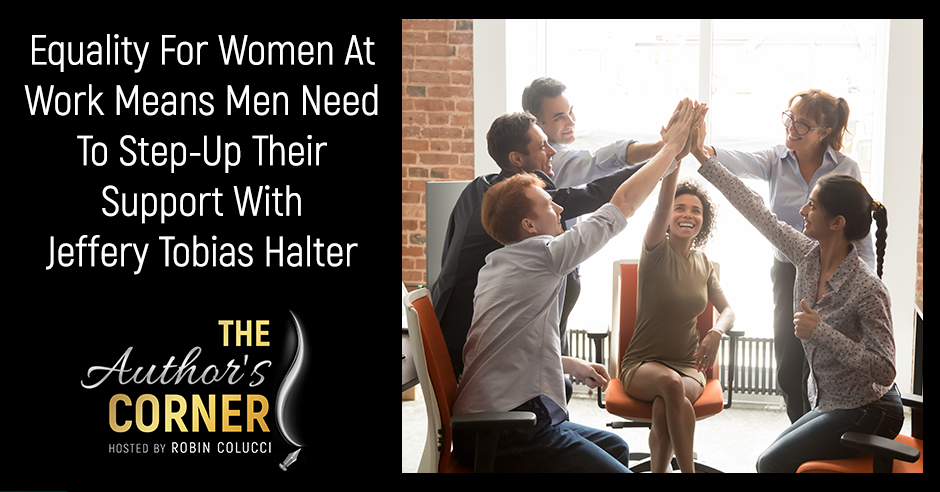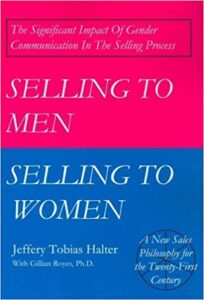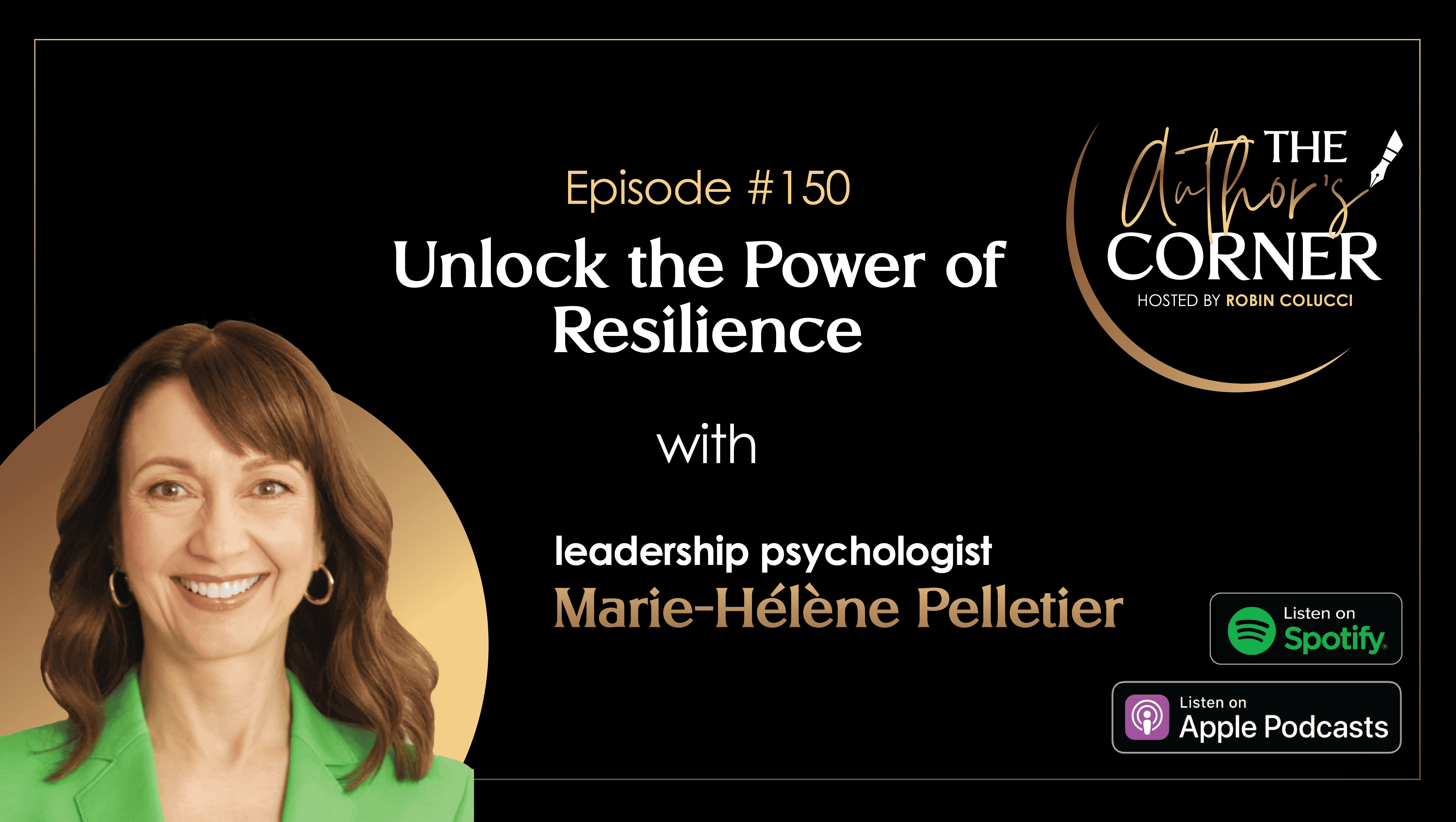
Men have an absolute responsibility to advocate equality for women in the workplace. Robin Colucci’s guest in this episode is Jeffery Tobias Halter, a consultant, author, gender strategist, and the President of YWomen. Jeffery explains that 75% of the problem in advancing women is in men, but men are also 75% of the solution. Women get less support from their managers and experience more microaggressions daily than men do. If companies want to drive change, they have to promote women. What are the things you can do to support equality for women at work? Listen to this episode and find out!
—
Watch the episode here
Listen to the podcast here
Equality For Women At Work Means Men Need To Step-Up Their Support With Jeffery Tobias Halter
I am very pleased to be tackling this conversation and question of how can we advance women and minorities in the space of entrepreneurship, business and certainly the business of publishing. To further our conversation and add some incredibly amazing insights, I have invited to join us, Jeffery Tobias Halter.
He is a thought leader on strategies that companies need to implement to accelerate their commitment to recruiting and advancing women in the workplace. He is a Gender Strategist and the President of YWomen, a strategic consulting company focused on engaging men and women’s leadership issues.
YWomen focuses on driving actionable business plans to help organizations create integrated women’s leadership strategies. He is the former Director of Diversity Strategy for the Coca-Cola company and the author of two books. His work, WHY WOMEN, The Leadership Imperative to Advancing Women and Engaging Men, focuses on the challenges and changes Corporate America needs to make to advance women.
His first book, Selling to Men, Selling to Women, explored gender communication in the sales process. He writes for numerous business publications and is a two-time TEDx speaker. His clients include IBM, Amazon, Bristol-Myers Squibb and dozens of other Fortune 500 companies. Join me in welcoming Jeffery.
—
Welcome to the show.
Thanks for having me on. I appreciate it, Robin.
It’s such a pleasure to have you here. We met a short time ago, but I was so fascinated by your work. I’m glad you’re here because it has a particular relevance for me, not only because I’m a woman. Even though I’m a self-employed woman, I’m still a woman in the workforce but also because I’ve become very interested in diversity, equity and inclusion within publishing itself, which has been predominantly a White male-dominated industry like so many.

An interesting phenomenon is that 75% of the workforce in publishing is women, but a much lower percentage of the executive tier is women and the percentage of people who are getting published is 75% male. With that little framing, I’m excited to have you here to talk about this. What are some of your observations overall with this particular issue?
I’m not an expert in the publishing industry. Most of my clients are Fortune 100, so I’ll speak to business but there’s a lot of overlap between specific industries, quite frankly, government, with what we’re going through and the work that I do. There are two things. One is the fact that I’ve been doing this work for many years and we’ve seen no movement in advancing women. It’s quite frustrating. From 2000, we’ve moved from about 17 female CEOs to 35. You could say, “We’ve doubled. It’s 100%.” It’s still 35 out of the Fortune 500.
I’ve spent the first twenty years of my career in sales and I always talked to executives about the fact that if advancing women were a revenue line or earnings per share line, you would have been fired years ago for lack of performance. One is, progress is still exceedingly slow. We’ve seen things saying, “It’s 200 years or 75 years to parody.” I’ve got some thoughts on that that are going to accelerate that. I’d be happy to share those. The other thing that is the core of my work is that there’s not enough men engaged in doing this work.
You’ve got a phrase that I use that you’ve commented on. It’s the fact 75% of the leadership is still men. I believe that 75% of the problem in advancing women is in fact men, but we are also 75% of the solution. Women have been working and leaning in doing everything they have to. The point is that’s only going to drive the numbers so far. You have to engage men.
I’m going to quote some research from the Mckinsey Women in the Workplace 2021 study. Everything I’m going to quote you is from that. Realize that this is 340 of the largest multinationals in the world. This is a big data sample. I’ll encourage your readers to download it. It’s fascinating research. What it says is 99% of companies are doing unconscious bias training, which isn’t working but only 14% are doing allyship training, which says we are actively recruiting and engaging allies in men to advance women. This, to me, is mind-boggling.
I’ve been doing this work for many years. We’re 75% to 85% of the problem and still only 14% of companies are doing it. Rather, this is what keeps me going every day. To be clear, I use gender as a gateway. I want to ensure your audience that when I’m talking about gender, it’s through a lens of intersectionality. I’m going to talk later about women of color, gender expressive or transgender and Millennials.
I have a very simple belief. I don’t think men are ready to have a conversation around gender in the workplace. Quite honestly, as a White man, if I can’t talk about that, how do you expect me to talk about race, being a transgender woman or a Millennial? I call it gender plus as a gateway. I wanted to put your audience at ease that I’m not just talking about women. I’m going to talk about this more significant issues people of color are facing but I want to be ultra-inclusive in that definition.

Something that continues to stand out for me is that until I met you, I’ve always looked at this the way I’ve been trained to, which is like, “What can women do? What could we do to help ourselves advance?” Maybe the point isn’t why we haven’t been asking what men can do but that’s worth pointing out. We haven’t even necessarily been asking how men might need to change or what men could do to help advance women.
It even goes broader than that. What I would tell you is, it’s corporate culture. The companies that are doing well in this work like Marriott, J&J, Deloitte and Salesforce. They’ve been at this for many years very mindfully pushing the rock to the point that they’ve got very good numbers. What happens too many times is company culture gets in the way. I’m going to give you a couple reasons around why we’re sitting here.
There was a company in 2008 that won the Catalyst Award, the highest award companies can win for advancing women, because they made a statement that said, “We’re going to put women in 50% of operating roles by 2020.” We know women migrate to staff roles. The key to the C-Suite is operating roles and P&Ls. Here’s the Catalyst Award. They didn’t accomplish anything but they took 100 women, trained, taught, coached and mentored them. They didn’t do a single element of training men, which I was consulting with them at the time and they didn’t buy into my proposal.
Here’s what happened. These 100 women over the course of the next twelve years, one by one failed to get ahead. It was one thing or another, mostly driven by the business. We’ve got high potential women. We restructured. They lost their sponsor. The new king, and it’s usually a king, gets to bring in his fiefdom. We probably lost 30% of the women to restructure. We lost them in the reorder. If you sold off a division, you lost six of those high potential women in that business you spun off and then their phones ring. They’re sitting at SVP level and I’m pleased to say that probably twenty of these women are sitting in the C-Suite, but they’re at another company.
This company that has 5 women from that class of 100 in 12 years made the C-level, not in operating roles but in significant staff roles. These are stories we don’t talk about. It’s the stuff that gets in the way. I spend my time talking to senior leaders and there isn’t a one that will say, “Diversity, equity, inclusion is a top priority. It’s number three on our list, but the number one got some more stuff. We’ve got to drive that top line. Number two is operating profit. We got to return that to shareowners.” They spend all their time on 1 and 2 and they never get to 3.
No one will argue it’s not the right thing and the numbers are overwhelming. Companies with more women in the C-Suite have more revenue from women and generate better business results. It’s from the McKinsey report. The business case has been made. What’s lacking is nobody’s doing it. We then get into the board level. There are not enough women on board if the board is in fact watching what the CEO is doing.
There has been some progress. BlackRock, the big mutual fund company, has sent a letter to their companies. This is fascinating. A good example is the California Teachers Association that has a huge investment fund. Both of them want complete transparency of numbers and parody in the boardroom. If we’re going to buy you as an investment, you need to step up. Progress is being made but it’s slow in coming.
75% of the problem in advancing women is in men, but men are also 75% of the solution. Share on XThat kind of pressure is still driven by women, if that’s a female-dominated profession, although I would also imagine that we’re probably going to see a similar disparity in that upper-tier.
It’s being driven by women and also by enlightened senior leaders. There are amazing companies out there. The CEO of Salesforce published gender equity. He was like, “Here is what everybody’s going to get paid and this is how things are going to work.” I work with a number of companies that have been at this for a long time. Their CEOs are committed. They have 35% to 40% of women in operating roles and in their C-Suite. 20 to 40 companies are doing this well. That still leaves over 900, plus all the little guys. I’ve got a lot of work. I have two new granddaughters. It’s like I’m working for them. Maybe they’ll get gender parody.
When you talk about company culture being in the way, what does it take to change company culture then?
It takes a number of issues. One is what I call an end-to-end business strategy. This is everything from consumer or customer all the way through complete accountability and transparency. Most companies have a number of programs that may or may not connect to drive the business. I spend a lot of time with business resource group leaders, phenomenal volunteers but think about this. You’re the head of a business resource group. I’m going to give you $20,000 and say, “You and your volunteers need to move the agenda forward for all women in the company.” That’s what’s happening.
The best-in-class companies understand who the customer and consumer are and the fact that women spend 83% of all the dollars in B2C. That’s everything that you can imagine, groceries and clothing. Women buyers influence 70% of car purchases. The fascinating one is the buyer influence. Women buyers influence 70% of home purchases. This influencing role is critical but does your sales force in fact know this?
If you’re in technology, there’s a great quote from the McKinsey study and that is you can’t show up with a bunch of 42 longs and expect to be successful because women are sitting on the procurement desk in 45% of companies. You can’t just show up with men. We’ll call that the revenue piece and then there are organizational barriers. These exist to some degree in most companies. It’s a lack of training, focus and accountability. We know women get less support from their managers and experience more microaggressions on a daily basis than men do. Women are left behind from their very first job.
For every 100 men promoted in their first job, it’s 86 women and 66 people of color. Think about this. Who thinks about that lowest first level? Those are the managers who have gotten no training in how to do unconscious bias like interviewing. Chances are they’re a team leader and they’re promoting their friends who are like them. It’s a complete lack of accountability and sponsorship.

This is from the McKinsey report and I find this jaw-dropping. Sixty percent of self-proclaimed advocates for advancing people of color. These are people who are saying they are advocates. Less than 20% of them will talk to them about a racial issue in either the news or the workplace and less than 10% of them mentor or sponsor a person of color. All these things conspire. It’s not one thing and that’s the hard part. The last element is a complete lack of accountability. They’re like, “If my boss never talks about it or if it doesn’t affect my paycheck, why should I care?”
The last barrier that is unspoken is fear. Most men are scared to death to have this conversation like, “I’m supposed to talk to Robin. Can I say I love her necklace? Can I open her door? Can we go to lunch together?” All the #MeToo stuff. I’ve heard companies say, “You can’t travel with women or be alone in a room with a woman.” This is a complete load of crap. This is abandoning your company values.
In every company, when you walk in their front doors, they have these values on the wall. They’re usually dust-covered. If we’re living those values, a woman should not have to worry about how she is treated. This is where the leadership needs to step up and do its job, which is talk about this and hold people accountable.
Women being left out of those things hinders their ability to advance.
That’s when things get done. You’ve got the impact of COVID, which is crippling the advancement of women. There’s speculation that women have lost ten years of advancement and progress that’s been made. COVID took 1 million more women out of the workforce. They haven’t recovered as quickly or come back. Women are burned out from the triple-double. The McKinsey report says 71% of men say they have stepped up to be more at home and 52% of women say men have stepped up. I believe men have stepped up but not stepped up enough.
Putting the toilet seat down an extra time every month is probably not what most women have in mind.
I tell people in a lot of my keynotes, particularly women in business, like, “Every year, you do a performance review with your team. Why don’t you go home and give your significant other a performance review around their performance supporting you during COVID? How many five-star performers are out there? What are the areas of opportunity?” We joke about this, but it’s true. Women are burned out.
Women get less support from their managers and experience more microaggressions daily than men do. Share on XThey feel they’re letting their families, spouses or teams down. They don’t think they’re a good enough boss. They’re letting their company down. Months into this, they’re wiped out and say, “I need to scale back.” One-third of the women in the workforce are thinking about scaling back and going into part-time. All this hard-won progress is being lost.
I imagine that’s also going to be rather expensive for companies.
That’s the element. That’s where women are going to win. You’ve got COVID and companies struggling. There are 11 million job openings in this country. There are 2 million jobs on LinkedIn and 11 million jobs need to be filled. Smart companies are doing whatever they can. They’re like, “If you can work this, let’s work with you.” It’s not because they’re nice companies, but there are no workers.
I was talking to a senior chemist I do work with a big pharma company and he said, “We’re curing cancer. I wake up every day curing cancer. Cancer has affected me personally. If I had a workforce that could work 24/7, that is exactly what I want, but I have fifteen job openings for organic chemists. If I don’t show flexibility or meet you where you are tomorrow, I’m going to have eighteen openings for organic chemists.” It’s a lot like Silicon Valley. They’re up in the Northeast. He said, “There are 80 biotech companies that are calling my best and brightest every day.”
This is the real world. Your best and brightest are getting calls. If you don’t think they’re going to leave, you are mistaken. This is where women will start to advance. There’s a phenomenon going on that no one’s talking about. Why do we have 11 million jobs? The economy is expanding, but for 15 years, 3 million Boomers a year have been leaving the workforce. Every day, 10,000 Boomers, old White men like me, leave the workforce.
With the new entries into the workforce, there are only about 800,000 people replacing the 3 million leaving and that 800,000 may not have the skillset needed to come into your company. This is where the war for talent gets interesting where companies are figuring out, “I need everybody and all hands.” There’s never been a better time for companies who want to drive change. They’re going to have to promote women and Millennials because there are not enough White guys around. Gen Z is bringing a whole new dimension into the workforce, who’s another great resource.
Deloitte publishes its employee transparency report and the ages of all its employees. Everybody thinks Gen Z are kids. They’re 24 and sitting in 50% of the entry roles at Deloitte’s public domain data. If you don’t think Gen Z is shaking things up much more so than Millennials, you are kidding yourself. You’ve got these generational classes and multiculturalism. The last point I would talk about is something we never stressed for the years I was in leadership development and that is empathy as a leadership competency.

I don’t say this with pride, but there was a point in my career when I had an admin for almost two and a half years and I didn’t even know her husband or children’s name. We were busy. It was just business. I was a remote worker. We talked on the phone but never went that far. Now, I have to take time and call Robin, who’s on my team. “How are you doing? What can I do to make your life a little easier? Is our frequency working? What’s going on in your life?” Everyone has a sick parent, child, spouse or stress.
I was doing a panel for a big tech company and it was during Asian Heritage Month. This was also the time there were Asian hate crimes out in the news. This woman, SVP, very accomplished and from Korea, was asked the question, “What’s going on in your life? What’s concerning you?” She said, “I love this company. This company supports me. For the first time in my life, I’m worried about my children going to school.” You hear this story and as a leader, how can you not say, “How can I support you? What can we do? What can the company do?”
That’s how you build loyalty and embrace this. By and large, not to say that empathy is a gender term, but most people would acknowledge women are better at empathy than men. Empathy is the next leadership competency that successful companies are going to implement. It’s as simple as, “How are you doing? What’s going on in your life? How can I make your life easier? Is the 3:00 PM staff meeting working? When do you drop your kids off? What’s going on with that?”
It takes fifteen minutes a week per person and it’s going to drive tremendous retention. The last part is the Boomers are going away. For 100 years, the lack of DNI has been an old White guy issue. The old White guys are all gone soon. For years, we were bought. This is a young White man’s issue. You’re based in Silicon Valley or San Francisco.
I’m based in Connecticut.
I’m sorry. I thought you were in the Bay Area.
We met in the Bay Area. That’s the context. My mother lives in that area.
If companies want to drive change, they have to promote women and millennials. Share on XHere’s the challenge. Most tech companies are run by young White men who have not demonstrated the capacity that they know how to leverage diversity any differently than their father did.
I’ve noticed that as well. I’m still scratching my head trying to figure out weren’t the Boomers also that whole hippie, free love and love one another. There are companies that gets lost in translation as soon as they get a car payment and mortgage.
I’m a flower child. I’m a child of the ‘60s. The ‘80s ruined the free love people, then we got capitalism.
How do we go from peace, love and understanding to the 30-something yuppie? It concerns me too because is it going to change or are they going to fall into the same pattern that their fathers or grandfathers fell into?
It’s still a locker room, frat-boy culture by and large. There are women who fit in that culture nicely. To a large degree, Millennial men value your skillset over your gender and so the women who have that skillset will thrive and do quite well, but I don’t know where they’re going to get enough workers. These 11 million job openings ranges from everything. There are 800,000 job openings in cybersecurity and the average starting salary is $125,000. You don’t even need a degree. You just need a certificate.
All these IT people in your company that you take for granted, they’re going to leave that $35,000 a year job and go into cybersecurity. We need 200,000 truck drivers and no one’s talking about this. Do you want to know why the supply chains are broken? It’s not just the ships in the harbor, but there are no more truckers. They’re all retiring and Millennials don’t want to drive a truck. For buildings, we have a plumbing, ironworker and electrical shortage.
When was the last time you went to a restaurant and had reasonable service? There is not an element of this economy that’s not being untouched by these eleven million people. The company has got to rethink this whole talent thing because eventually, technology may get your order faster at Wendy’s, but it’s not going to be an electrician showing up at your house. We still need those. Millennials, by and large, aren’t going to tech school, so what are we going to do? I’m hopeful and optimistic.

We can invite some immigrants. What are the jobs that they’re stealing anyway? Apparently, we have more than enough jobs.
I don’t know. That’s a whole other hour and a glass of wine.
Let’s circle back to when you’re having a conversation with a White male executive. Are you getting pushed back? What’s going on in that conversation?
It’s fascinating because the folks I’m talking to have that as priority number three. More or less, the majority of them in the room have the simple question of, “You’ve convinced me. What do you want me to do?” I have a very simple acronym and I’ll explain each of these. It’s called Listen, Learn, Lead and have the Will. For listen, I want you to go have coffee with 10 women and 10 people of color who work for you. I want you to ask them a simple question. “Tell me about the experience you’re having in the workforce.”
Don’t be surprised when Molly doesn’t say anything because she doesn’t want to represent all women in the company. Ask again, “Molly, is there something I’m not understanding?” Don’t interrupt her. When she raises an issue, don’t mansplain back to her. Just listen and then ask a third time. In the last ten minutes, you’re going to start to hear root cause issues of microaggressions and gender bias of the workforce. Things that might seem minor to you, but they were a big deal to her. Rinse and then repeat. Go and talk to as many people as you can. If you’re at a very high level, do focus groups and ask people what’s going on. That’s the listen element.
The learn part is that you have to talk to your organization about the business case and talent. You have to push it down as far as you can. What is the business case for your company? How does it affect customers, consumers and talent? IKEA has a very informal program. Every department-level manager has to write a diversity plan for their department.
They go and sit down with their district manager in their cafeteria and eat meatballs. On a simple white sheet of paper, they write down the five things that they’re going to do for the year. They’re like, “I’m going to make sure I interview diverse candidates and train people to be ready to go.” How do you start to talk about this and the dynamics of issues people of color are having? What does gender non-binary even mean and you’d come conversation on this? That’s the learn part.
Women are better at empathy than men, which is the next leadership competency that successful companies will implement. Share on XThe lead part is you got to hold people accountable and this gets a bad rap sometimes. You have to set goals and targets. That says, “We are going to move to women in 50% of roles in the next 3 years.” I’m not saying go out and hire women. It is not a pass-on capability. Gallo was one of my clients and they have a great comment. They said, “We would not use bad grapes to make great wine.” Every time a woman gets promoted, the company thinks, “She didn’t deserve that job.” You got to trust your company that they have quality control.
Rarely have we ever said, “He got that job because he’s a man,” even if it’s a lot more likely. The other one and this is a little controversial, is I have heard women say, “I wouldn’t want that job if the only reason I got it was I was a woman.” That was said by no man ever. In any of the job, even if I’m incapable, I’ll fake it until I make it. If you get offered an opportunity, go in and prove them wrong.
At the very top, you got to say, “Jim, I don’t see any diverse candidates on your development slate. What’s going on with that? You got a job opening in the Eastern region for a director job and three of your buddies posted here. What’s going on?” Jim will probably say something in the effect of, “We don’t have any ready.” Many times, a senior leader will go, “I understand.” Instead of doing their job, which is Jim, you better get some ready or I’m going to put somebody in your job who can get somebody ready. Do what leaders do. Ask questions and hold people accountable.
The last one is having the will. I call this the head and heart. Those first three, listen, learn and lead are around the head or business. Having the will means how do you become an advocate and a visible vocal? How do you talk about advancing women when there aren’t any in the room? I have found that the will comes from personal connection. To be an advocate for anything, it’s very hard if you don’t have a direct connection, whether that’s a nonprofit or maybe a disease that took a family member.
In this space, I’d put myself at the center of this because this came to me very late in life, what I found is I didn’t make the connection that if I’m not advocating for women, I’m hurting my spouse, my working mother, sisters and daughter. My daughter is going to enter the workforce and be faced with the same bias that I know exists that’s all over my organization. She’s going to make $0.83 for my son. The will come from having that compass and due north. “Why are you doing this work?” I have an initiative called the father and daughter initiative.
I believe men have an absolute responsibility to do this work. It sounds simple, but this simple pledge is groundbreaking to a lot of men and it’s because they never thought about it. I did a keynote for a large company. This guy came up and said, “I’m the VP of sales of five regions. I have men running 5 of them and also 5 daughters. I can’t tell you how embarrassed I am. I am going to go out and change this because I never thought about it.” It was like this epiphany. That’s the will part.
I’ve got a bunch of free stuff on my website. One is the father and daughter pledge, an advocating for women pledge and broader actions for advocates that are encompassing of gender plus, people of color, ages but the men I find who is doing this work well have made that simple connection and it drives them to do this work. We need to create more of them.

Jeffery, thank you so much. This has been so informative and enlightening. I so appreciate you taking the time to be here. Where can our readers go to get some of these free goodies from you?
If you go to my website, www.YWomen.biz, there are a number of free tools. I want you to learn. You can download almost 100 white papers. Any one of them can be a staff meeting. Download it, share it at your staff meeting and talk about it. I have a free online assessment called the Male Advocacy Profile. It’s twenty questions. The first 10 are around how you think about gender equity and the next 10 are around the actions you choose to take. There’s also a version for women and gender-nonconforming because even women think about gender equity more than taking action.
The last thing I’ve got is a free staff meeting in a box called Creating Gender Advocates. You can download it. It’s an hour-long staff meeting. It’s self-facilitated. At this point in my career, I give away a lot of my stuff because I want to go out and drive change for the men and women in my life, so thank you for asking.
Thank you so much. These all sound fantastic. I’m thinking of lots of people and I’m like, “I got to make sure to tell them about this.” Jeffery, thank you for being on the show.
It’s my pleasure. Thank you, Robin.
Important Links:
- YWomen
- WHY WOMEN, The Leadership Imperative to Advancing Women and Engaging Men
- Selling to Men, Selling to Women
- Women in the Workplace 2021
- Male Advocacy Profile
- Creating Gender Advocates
- https://www.LinkedIn.com/in/jefferyhalter/detail/recent-activity/posts/
About Jeffery Tobias Halter
 Jeffery Tobias Halter is a Consultant, Author, Gender Strategist and the President of YWomen, a strategic consulting company focused on engaging men in women’s leadership advancement. YWomen focuses on driving actionable business plans and strategies to help organizations create Integrated Women’s Leadership Strategies. Jeffery is the former Director of Diversity Strategy for The Coca-Cola Company.
Jeffery Tobias Halter is a Consultant, Author, Gender Strategist and the President of YWomen, a strategic consulting company focused on engaging men in women’s leadership advancement. YWomen focuses on driving actionable business plans and strategies to help organizations create Integrated Women’s Leadership Strategies. Jeffery is the former Director of Diversity Strategy for The Coca-Cola Company.Love the show? Subscribe, rate, review, and share!






